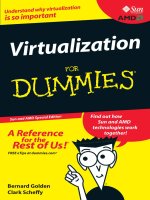Prentice hall broadband network architectures designing and deploying triple play services may 2007 ISBN 0132300575 pdf
Bạn đang xem bản rút gọn của tài liệu. Xem và tải ngay bản đầy đủ của tài liệu tại đây (7.61 MB, 600 trang )
www.sharexxx.net - free books & magazines
BROADBAND NETWORK
ARCHITECTURES
The Radia Perlman Series in
Computer Networking and Security
Radia Perlman, Series Editor
Dusseault
WebDAV: Next-Generation Collaborative
Web Authoring
Hellberg, Boyes, and Greene
Broadband Network Architectures: Designing
and Deploying Triple Play Services
Kaufman, Perlman, and Speciner
Network Security: Private Communication in
a Public World, Second Edition
Liska
The Practice of Network Security: Deployment
Strategies for Production Environments
Mancill
Linux Routers: A Primer for Network
Administrators, Second Edition
Maufer
A Field Guide to Wireless LANs for
Administrators and Power Users
Mirkovic, Dietrich, Dittrich,
and Reiher
Internet Denial of Service: Attack and Defense
Mechanisms
Skoudis with Liston
Counter Hack Reloaded: A Step-by-Step Guide
to Computer Attacks and Effective Defenses,
Second Edition
Skoudis with Zeltser
Malware: Fighting Malicious Code
Solomon
Mobile IP: The Internet Unplugged
Syme and Goldie
Optimizing Network Performance with Content
Switching: Server, Firewall, and Cache Load
Balancing
Tomsu and Schmutzer
Next Generation Optical Networks
BROADBAND NETWORK
ARCHITECTURES
DESIGNING AND DEPLOYING
TRIPLE-PLAY SERVICES
CHRIS HELLBERG, DYLAN GREENE, TRUMAN BOYES
Upper Saddle River, NJ • Boston • Indianapolis • San Francisco
New York • Toronto • Montreal • London • Munich • Paris • Madrid
Capetown • Sydney • Tokyo • Singapore • Mexico City
:
Many of the designations used by manufacturers and sellers to distinguish their products are claimed as
trademarks. Where those designations appear in this book, and the publisher was aware of a trademark claim,
the designations have been printed with initial capital letters or in all capitals.
The author and publisher have taken care in the preparation of this book, but make no expressed or implied warranty of any kind and assume no responsibility for errors or omissions. No liability is assumed for incidental or consequential damages in connection with or arising out of the use of the information or programs contained herein.
The publisher offers excellent discounts on this book when ordered in quantity for bulk purchases or special sales,
which may include electronic versions and/or custom covers and content particular to your business, training goals,
marketing focus, and branding interests. For more information, please contact:
U.S. Corporate and Government Sales
(800) 382-3419
For sales outside the United States, please contact:
International Sales
Library of Congress Cataloging-in-Publication Data:
Hellberg, Chris.
Broadband network architecture : designing and deploying triple play services / Chris Hellberg, Dylan Greene,
Truman Boyes. -- 1st ed.
p. cm.
ISBN 0-13-230057-5 (pbk. : alk. paper) 1. Broadband communication systems. 2. Computer network architectures. I. Greene, Dylan. II. Boyes, Truman. III. Title.
TK5103.4.H47 2007
621.382'15--dc22
2007005085
Copyright © 2007 Pearson Education, Inc.
All rights reserved. Printed in the United States of America. This publication is protected by copyright, and permission must be obtained from the publisher prior to any prohibited reproduction, storage in a retrieval system, or
transmission in any form or by any means, electronic, mechanical, photocopying, recording, or likewise. For information regarding permissions, write to:
Pearson Education, Inc.
Rights and Contracts Department
75 Arlington Street, Suite 300
Boston, MA 02116
Fax: (617) 848-7047
ISBN 0-13-230057-5
Text printed in the United States on recycled paper at R.R. Donnelley in Crawfordsville, Indiana.
First printing, May 2007
This book is dedicated to J.B.
This page intentionally left blank
CONTENTS
Foreword
Preface
About the Authors
Chapter 1
xv
xxi
xli
A History of Broadband Networks
1
Legacy Access Networks
Copper
DSL Evolves
The Telecommunications Act of 1996
Challenges to DSL Access Networks
DSLAM Evolution
Early DSL Termination
Remote Line Card Shelves
ATM DSLAMs
Ethernet DSLAMs
Service Evolution
Residential Access Servers
User Credentials
Early User Access Implementations
DSL Forum Broadband Access Device Requirements
Evolving DSL Architecture
Today’s Broadband
What’s Next?
Summary
2
3
6
9
10
11
12
12
13
14
15
15
15
16
19
21
30
31
33
vii
CONTENTS
Chapter 2
Next Generation Triple-Play Services
Network Topology
Video Over IP
IPTV
Video on Demand
Media Encoding, Security, and Encryption
Middleware
Video Services
Data Services
Premium Gaming
Walled-Garden Services
Business Connectivity
Voice Services
POTS Access to DSLAM
End-to-End VoIP
Summary
Chapter 3
viii
35
36
40
41
45
51
53
53
55
56
58
59
63
64
64
66
Designing a Triple-Play Backbone
67
MPLS Backbone Networks
Policy Forwarding
VRF Route-Target Leaking
Hybrid VPN and Non-VPN Routing Models
Non-MPLS Networks
What Type of Network Is Best?
Multicast Protocols in the Backbone
Deploying Native IP Multicast
Using P2MP LSPs for Multicast Data Delivery
Delivering Multicast Using VPLS in the Core
Running MPLS on the BNG
Connecting the BNG to the Wider World
Using IGMP with PIM-SSM Mapping
Designing a Highly Available Core Network
Using Multiple Injection Points with a Single Source Address
Highly Available Routing and Signaling Protocols
in the Core
Summary
68
71
74
76
77
77
79
79
85
92
96
97
99
106
107
108
116
CONTENTS
Chapter 4
Designing a Triple-Play Access Network
Ethernet DSLAMs
Overview of an Ethernet DSLAM
Subtended DSLAMs
Other Transport Models
DSLAM Aggregation
Pseudowires
Traditional Transport
VPLS
VLAN Architecture: N:1 or Service VLANs
Provider VLAN Architectures: 1:1 and Multicast VLANs
Feature Comparison
High-Availability Broadband Access
Requirements
Measuring Availability
BNG Architecture
High-Availability Ethernet Access Architecture
Pseudowires
VPLS Topology Discovery
Summary
Chapter 5
Choosing the Right Access Protocol
PPP for Broadband Networks
PPPoA
An Overview of PPPoE
DHCP for Broadband Networks
DHCP Address Allocation Models
Choosing Between PPP and DHCP
Advantages of PPPoE
Disadvantages of PPPoE
Advantages of DHCP
Disadvantages of DHCP
Access Protocols in an IPv6 Environment
Summary
Chapter 6
Evolutions in Last-Mile Broadband Access
ADSL Access
G.DMT
G.Lite
117
118
118
119
121
122
123
145
146
156
162
168
170
170
171
173
175
177
177
182
185
186
188
190
196
198
207
207
209
211
213
216
216
219
220
222
227
ix
CONTENTS
ADSL2 and ADSL2+
ADSL2 Features
ADSL2+
VDSL and VDSL2
VDSL Physical and Electrical Characteristics
VDSL2
Copper Network Reticulation Considerations
SHDSL
Standards and Spectrum
Physical and Electrical Characteristics
Transport Capacity
Summary
Chapter 7
Wholesale Broadband Networks
Local Loop Unbundling
Bit Stream Access
ATM Interconnects
Ethernet Interconnects
Redundant Bit Stream Interconnects
Layer 3 Wholesale
L2TP Wholesale
L2TP for Narrowband Networks
L2TP for Broadband Access Networks
L2TP Tunnel Switching
Subscriber Authentication
DSL Port Identification
L2TP Fragmentation
High-Availability L2TP Access
Anycast LNS
LAC-Based Load Balancing
Dedicated LNS Load-Balancing Hardware
Wholesale Access Models Compared
Summary
Chapter 8
Deploying Quality of Service
Why Is QoS Needed?
Limited Bandwidth
Jitter
x
227
228
229
230
230
233
234
235
236
237
239
239
245
246
249
249
253
256
259
261
262
263
270
272
276
277
280
281
282
283
283
286
289
290
291
291
CONTENTS
Business Strategy
What Is QoS Not?
History of QoS
Integrated Services
Differentiated Services
Call Admission Control
Building Blocks of QoS
Classification
Marking
Rate-Limiting
Queuing
Scheduling
Router Forwarding Architectures
Triple-Play QoS Architectures
Trust Boundaries
Centralized BNG
Distributed BNGs
ANCP and the Access Network
Summary
Chapter 9
The Future of Wireless Broadband
Road Map to Wireless Broadband
IMT-2000
GSM Evolution/3GPP
CDMA Evolution/3GPP2
Wireless Access Network Basics
Packet Services Versus Circuit Services
GPRS System
3GPP Structure
3GPP Architecture
3GPP QoS
IMS
IMS Architecture
Fixed/Mobile Convergence (FMC)
WLAN Integration
Dual-Mode Handset (DMH)
Generic Access Network (GAN/UMA)
SIP-Based FMC
Voice Call Continuity (VCC)
292
293
294
296
296
300
301
301
306
306
313
318
342
346
346
351
356
357
360
363
365
365
367
370
372
374
375
377
379
380
381
384
389
390
391
391
393
394
xi
CONTENTS
Wireless Video Integration
Digital Mobile Video Broadcast
Multicast Broadcast Multimedia Services (MBMS)
Digital Video Broadcasting-Handheld (DVB-H)
Media Forward Link Only (FLO)
Wireless Broadband Evolution
HSDPA/HSUPA
Beyond CDMA
Summary
Chapter 10 Managing IP Addressing
Setting up the Connection to the BNG
Local Address Pools
Remote Address Pools
Assigning Addresses to DHCP Clients
Assigning Static PPP Addresses
Routing Subscriber Addresses
Customer LAN Addressing
PPPoE or DHCP
Routing or Bridging
Triple Play with IPv6
Protocol Changes
Router Hardware and Software Support
Supporting Protocols
Deployment Scenarios
Summary
Chapter 11 Dynamic User Session Control
Residential and SME Dynamic Service Provisioning
Basic Service Management Elements
Service Provisioning Flow
Basic Dynamic Service Provisioning
Advanced Dynamic Service Provisioning
Summary
Chapter 12 Security in Broadband Networks
Denial of Service
Reverse Path Forwarding
Residential Gateway Security Features
xii
395
396
396
397
399
399
401
402
403
405
406
407
411
414
420
421
427
427
428
430
431
432
434
436
441
443
445
446
451
452
459
468
469
470
471
472
CONTENTS
Broadband Network Security and VoIP
The Security of VoIP and Credentials
Session Border Controllers as Application Layer Proxies
Transport Security Issues with VoIP Networks
Wholesale VoIP Security on Broadband Networks
Lawful Interception in Broadband Networks
Triggers on BNG Interfaces
Confidentiality
Denial of Service on Authentication Systems
Solutions for Enhancing Security on Authentication Systems
Authenticate and Accept All Requests
Password-Free Networks
Load Balancing of Authentication Systems
Securing Video Distribution Systems
Multicast Join State and Speed with Broadcast Channels
Multicast Group Access Lists with Broadcast Channels
Video on Demand Security
Protecting the Control Plane in the Routing Infrastructure
Suspicious Flow Detection
NetFlow/J-Flow/C-Flow Statistical Collection
Packet Filters
Blackhole/Sinkhole Routing
Summary
474
475
475
477
478
480
480
481
481
482
482
483
483
484
484
485
485
486
487
488
489
489
492
Appendix A Glossary of Acronyms and Key Terms
495
Appendix B Glossary of Packet Diagrams
523
IPv4 (RFC 791)
IPv6 (RFC 2460)
TCP (RFC 793)
UDP (RFC 768)
Ethernet II
ATM AAL5 PDU
LLC Encapsulated PPP over AAL5 (RFC 2364)
PPPoE Ethernet Payload (RFC 2516)
PPPoE TAG TLV (RFC 2516)
PPPoE PADI (RFC 2516)
523
524
525
525
526
526
527
527
528
528
xiii
CONTENTS
PPPoE PADO (RFC 2516)
PPP LCP (RFC 2516)
L2TPv2 Stack Overview (RFC 2661)
L2TP Header (RFC 2661)
L2TP AVP (RFC 2661)
DHCP (RFC 2131)
DHCPv6 Client/Server (RFC 3315)
DHCPv6 Relay (RFC 3315)
DHCPv6 Option TLV (RFC 3315)
RADIUS (RFC 2865)
Index
xiv
529
530
530
531
531
532
533
533
534
534
535
FOREWORD
The broadband industry has evolved significantly since it first came to the attention of the general public around the late 1990s, at the time of the dot-com
euphoria. The initial focus was on best-effort Internet access at speeds significantly faster than dial-up modems or ISDN. This was enabled by the advent of
new high-speed access technologies, including ADSL, cable modems, and WiFi.
More recently, ADSL2+, SHDSL, VDSL2, WiMax, Fibre-to-the-Curb/Home, and
HSDPA in 3G cellular networks have kept up the momentum of increasing the
availability and speed of broadband access. The increased availability and affordability of broadband access have caused it to overtake dial access in many markets, with adoption rates faster than those seen for television, VCRs, and cell
phones.
Once the initial Internet-centric broadband networks had been deployed, application developers and service providers turned their attention to other uses for
these broadband access connections. The next phase of development saw the
deployment of voice services that leveraged the IP transport and access speeds of
broadband to offer cost-effective VoIP services, often with new features. These
services could be offered independently of the access provider (such as Skype
or Vonage) by relying on the sheer speed and capacity of broadband access to
the Internet to facilitate adequate QoS. Alternatively, some broadband access
providers evolved their architectures to provide fully engineered QoS between
xv
FOREWORD
the customer’s phone and the VoIP softswitch to guarantee QoS. This enabled
them to ensure that the quality of the voice call would always be as good as
analog primary-line voice (as measured by Mean Opinion Score [MOS]). The
combination of data plus voice in such product offerings became known as
“double play.”
The broadband industry has entered a new era of “triple-play” service bundles, in
which service providers offer data, voice, and video services in a single package.
Typically, DSL network operators approach this by adding video services to their
data and voice foundation products, whereas cable operators have added data,
voice, and Video on Demand (VoD) to their foundation broadcast video products. Triple play then becomes an essential approach for broadband network
operators to enable them to better compete with each other and reduce churn
(the number of customers changing service providers). By offering a service bundle, some services have even been marketed as “free” in certain countries since
their cost is offset by revenues from the other services in the bundle. Ironically,
ADSL (which is the most widely deployed broadband access technology) was initially conceived in the late 1980s/early 1990s for video services such as Video on
Demand (VoD). However, at that time the cost of video servers, video encoders,
and set-top boxes made commercial deployment prohibitive. Hence, ADSL was
“repurposed” for the emerging Internet access market.
This bundling of services over a single converged IP network to both reduce costs
and increase functionality presents a number of challenges to network providers.
Bundling will increasingly highlight the quality of network engineering as a competitive differentiator due to its profound impact on service performance, functionality, cost, and time-to-market for new products. In the era of single play, it
was possible to simply rely on the increase in access speeds (such as moving from
dialup to ADSL) to keep the customer happy. Most Internet access was used to
surf the World Wide Web (WWW) or to send and receive e-mail. WWW content
was predominantly static graphics and text with limited streaming. The only
early streaming content was low-bandwidth radio stations. Hence, network providers could get away with simply using bandwidth to provide adequate QoS.
They could also rely on TCP’s packet retransmission feature in the architecture’s
TCP/IP protocol stack to cover up any IP packet loss due to inadequate engineering or intermittent congested network links. When the market moved to
xvi
FOREWORD
doubleplay, some network providers could still “get away with” sloppy network
engineering just by using more capacity to transport the small, incremental
bandwidth required for voice services so that most times call quality was just
good enough. The lower pricing of the double-play service bundles meant that
many customers would tolerate the occasional quality aberration. Of course,
some network providers did properly engineer double-play services, but MOS
quality of VoIP is not something that is easily used as a competitive performance
metric in marketing to consumers. However, as the broadband industry has
moved toward triple-play bundles, adding video to the service mix means that no
shortcuts can be taken. Video has extremely onerous quality requirements, and
any network engineering deficiencies are immediately apparent to the customer
(in terms of subjectively annoying video artifacts or sound-track problems).
Hence, this will really sort out “the men from the boys” in terms of network
architecture and implementation.
As video compression evolves and deployment of HDTV over broadband networks increases, the sensitivity of the customer's Quality of Experience (QoE) to
the network architecture and its implementation will increase. Inadequacies in
network architectures that result in detrimental jitter, packet loss, and multicast
channel change latency will be immediately apparent to the customer. Standardized approaches to multiservice broadband architectures do exist, such as DSL
Forum TR-101, which provides a QoS and multicast blueprint. However, there is
still a need to understand at a detailed design level how to integrate the various
network components to implement a highly capable network. This book provides you with knowledge of the key design decisions and approaches so that you
can architect a competitive broadband network for the 21st century.
The role of core networks in broadband architectures is predominantly to shift a
lot of bits quickly and reliably. Hence, the design focus is on cost-effective, resilient “fat pipes.” A degree of sophistication has been added as networks evolved to
triple play—for example, point-to-multipoint MPLS LSPs for transporting multicast traffic. However, core networks generally stick to the architectural principles of big, quick, reliable, and simple. If the core of the network is the muscle,
the edge of the network is the brains. The network “edge” is typically a regional
Point of Presence (PoP) or metronode where traffic from end-user customers is
aggregated. In contrast to the core of the network, the speed of traffic at the network edge nodes means it is technically viable to “touch the traffic” to invoke
xvii
FOREWORD
policies on a per-user basis. This can be used as the basis for many innovative
products, such as bandwidth on demand, byte-metered services, and so on. It is
also a key IP policy enforcement point to ensure that the triple play of data, voice,
and video services can be transported to the customer with adequate QoS.
The architectural approach of applying policies to traffic on a per-flow, percustomer, and perhaps dynamically time-varying basis facilitates innovative
network products. This seems set to continue as Deep Packet Inspection (DPI)
technology is leveraged to provide application-aware networking. This leads to
the concept of a programmable or self-configuring network. In the past, new network service deployment was often characterized by the “lift and shift” of boxes
as new equipment and network links were deployed to support the new product
offering. With modern broadband networks operating in highly competitive
markets, delays in time to market are unacceptable. Hence, once the fundamental
plumbing of broadband IP/Ethernet access and metro networks is deployed,
new-product development ideally becomes a case of designing new policy profiles and adding these to the policy database. The panacea is customer selfprovisioning via mass customization. For example, somebody running a florist
business from home may want to turn on some additional voice lines on her
broadband connection to take on student labor to handle the increase in calls
before Mother’s Day. Ideally they should be able to simply log on to a web portal,
click an upgrade option, and have the additional voice lines automatically
enabled. The network would simply invoke a new policy (at the edge and customer premises equipment), and the charges would automatically ripple through
to the billing system, with no human intervention. The technology exists to make
this feasible, but the key is the architecture of the broadband network and its
associated policy management infrastructure.
Any network operator with deep-enough pockets can increase capacity and fiber
link speeds in the core and metro. However, last-mile access will always be a
potential bandwidth bottleneck, especially with the advent of HD-TV with IPTV.
It can be complex to design broadband networks to most effectively exploit techniques such as hierarchical scheduling for QoS and leveraging multicast techniques. However, the resulting benefits in service capability, customers’ quality of
experience, reduced operational costs, more efficient use of capital invested in
the network, and subsequent rapid product development justify it. Hence, an
xviii
FOREWORD
effective, efficient broadband network architecture and its associated engineering
design and policy management are vital in today’s competitive market and will
become a key differentiator between network providers. This looks set to continue as network providers look beyond triple play toward quadruple play, in
which cellular/mobile traffic is added to the service mix to provide fixed mobile
convergence.
It is all very well to build an information superhighway. However, a highway
results in carnage without the existence of rules and their enforcement. Hence,
the design of the highway code, law-enforcement policies, and infringement penalty systems are critical to make the whole infrastructure work for multiple users.
The same is true of broadband networks. This book helps you understand and
engineer future-proof broadband network architectures capable of handling the
complexities of bundled services and sophisticated traffic policies.
—Gavin Young
Chief Architect, Cable & Wireless Access
DSL Forum Technical Chair
January 2007
xix
This page intentionally left blank
PREFACE
When ADSL hit the market in the late 90s, the residential broadband market
started to really heat up. Dial-up Internet access, while being a well-understood
and reliable service, could not keep pace with the demands of having homes connected at broadband speeds. Cable networks, with their hybrid fiber and coax
networks, were also competing for similar customers as traditional Telcos.
Thanks to cable operators, triple-play services had already gained a foothold in
the customer conscience as a service bundle that can be provided by a single
company. This eased the way for Telcos to also deliver their own triple-play service bundles over a single copper pair—the same copper pair that was used for
many years as a simple telephone line.
A triple-play package is a bundle of an Internet, video, and VoIP service. Video
services almost always have two components: a Video on Demand, and an IP
Television (IPTV). IPTV takes traditional terrestrial and satellite channels and
delivers them over an IP network to the customer premises. Multi-play services
are an extension of this concept and divide Internet access into more sophisticated services with specialized Quality of Service handling.
Until the early to mid part of this decade, apart from some early-adopters, service providers were not given to broadening their residential data portfolio past
Internet access. This mindset is rapidly changing, and the market is diverging
xxi
PREFACE
into two segments. The first segment is the commodity ISPs, who provide a
cheap and fast Internet service. The cost-barrier to entry is lower due to the lower
service overhead; the competition here is fierce. The second segment is to whom
this book is aimed—those providers in, or looking at, getting into the triple- and
multi-play service market.
Several reasons drive the diversification. From a political perspective, many Telcos with wired access are finding their traditional revenues being eroded due to
regulatory pressures. Triple- and multi-service bundles are an ideal way to maintain some service margin in an increasingly competitive market. For access seekers, regulatory intervention is a much cheaper way to expand network coverage
compared to an expensive copper or fiber access network rollout. For both
wholesalers and access seekers, there was a major drawback to video service
deployment: ADSL does not have much bandwidth to play with. ADSL2+ pushes
up the downstream limit to over 24Mbps, giving ample headroom for highdefinition IPTV channels, while not making a severe impact on Internet
performance.
This book is the perfect companion for anyone in the networking industry. If you
are a journalist or analyst who wants more inside, in-depth information about
next-generation broadband access networks, you will find it here. Or if you work
at a vendor or service provider, the architectures and configurations enhance
your technical understanding with practical applications of protocols and
hardware.
ATM-based DSL networks are well understood and have been in the marketplace
for many years. There are already one or two books on these broadband networks. However, this book fills the gap in the market for a leading-edge architecture guide of next-generation, Ethernet-based DSL networks and triple- and
multi-play services. Because this book is more about architectures than focusing
exclusively on technology, this book appeals to a wider audience than just technicians. Planners, financial controllers, managers, and network architects will also
find useful information. The designs and techniques described in this book apply
to many markets around the world.
xxii
WHAT YOU WILL LEARN
The intent of this book is to inform the reader of best practices in the industry,
and where there is still contention, the pros and cons of each alternative are laid
out. For example, North American providers generally choose to go with a
customer-specific VLAN architecture, whereas European providers prefer to use
a service VLAN. Explanations of these terms and the advantages and disadvantages of each are two examples of the flexible approach that this book attempts
to provide.
Many readers already in the industry will be familiar with the topics in each
chapter, but the concepts in the latter parts of each chapter are not intended for
beginners. For example, many of the MPLS concepts in Chapter 3, “Designing a
Triple-Play Backbone,” are not intended for those whose exposure to MPLS is for
the first time. The description for each of the 12 chapters listed in the next section tells the reader the intended technical level, along with any recommended
reading titles.
WHAT YOU WILL LEARN
After reading this book, the reader will have enough knowledge to work through
the issues and challenges involved with designing and deploying a triple- and
multi-play network. There may be times where there is not enough detail in a
particular section. The intention has been to cover at least the basics, so the
reader at least knows what issues are involved if they need to do more research.
Most of the IETF RFC-based technologies have been referenced by URL for further investigation. Although Wikipedia might not be 100% accurate, for technical information it is a reliable and useful resource for unfamiliar topics. As of
January 2007, PDFs of in-force ITU-T specifications are freely downloadable.
These are quite specific in nature and are good when needing to delve deep into
specific aspects of a DSL modulation, for example. Also included at the end of
the book are two glossaries: a comprehensive glossary of terms, and a list of
packet diagrams for many of the protocols described in this book.
xxiii
PREFACE
MULTI-VENDOR ROUTING
We have tried throughout this book to give an independent rendering of broadband network architectures. Because all of us currently are employed by Juniper
Networks, the reader may see some emphasis given to Juniper’s routing technologies and protocols as opposed to Cisco Systems. This is not intentional but
merely a fact of life that we all live and breathe one routing set of equipment.
Where appropriate, we have posted listings throughout the book that show both
Juniper and Cisco configurations whenever they differ large enough to draw
attention to themselves.
Because the focus of this book is on architectures, the basic principles do not
change depending on what vendor supplies your routing equipment. Often one
vendor will be stronger in one area over another. For example, their system
might be better at handling DHCP over PPP, or might have a limited VLAN
capacity, so prefers the N:1 over the 1:1 approach. Therefore, vendors differ in
their recommendations for broadband network architectures; this is normal.
This book has tried to present neutral, but smart network choices; and where
there is still contention in the marketplace, to present as much information as
possible. So, armed with the right information, the reader can make the best
choices for their network.
PLAYERS IN THE STANDARDS WORLD
IETF
The development of the Internet has been accomplished through the cooperation among various commercial entities, government agencies, and educational
institutions spanning multiple countries, all working toward the common goal of
improving communications. Although this development happens through a
larger network of cooperation, a central administrative authority is required to
produce protocol specifications, operational guidelines, address assignment, and
other standards. The Internet Engineering Task Force (IETF) is the body that
oversees the Internet standards process.
xxiv









